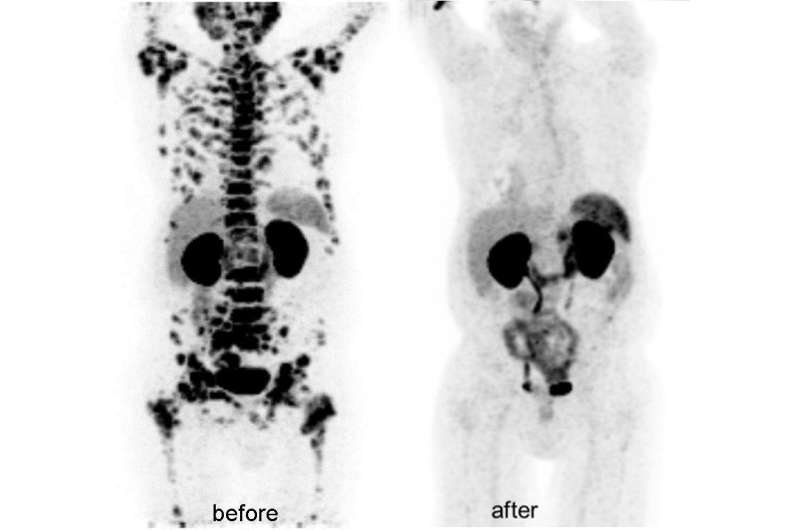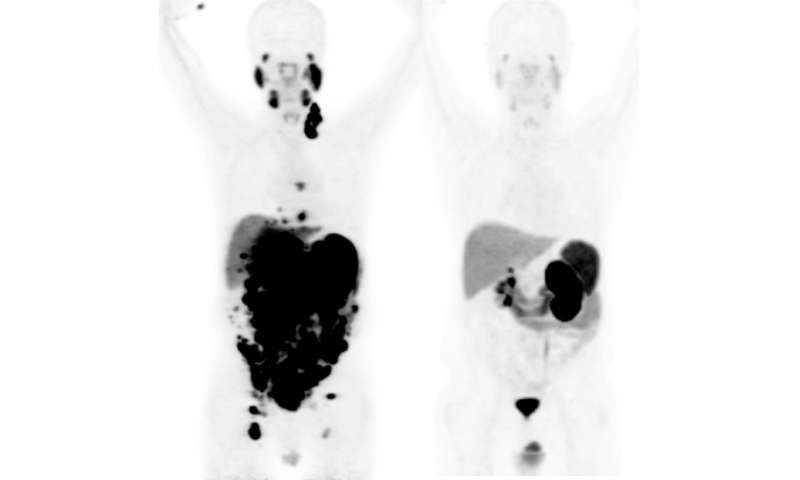Targeted alpha therapy shows impressive results for metastatic prostate cancer patients
by CORDIS

Nearly three years of research have brought about remarkable results for the majority of 80 patients subjected to targeted alpha therapy of metastatic prostate cancer. The first assessments – describing a full response in two patients in critical clinical condition with extensive metastases – are published in the December issue of the Journal of Nuclear Medicine (JNM), which has displayed images depicting the improvements on its cover page.
The tumour has completely disappeared in the two patients after three to four treatments (Figs. 1 and 2) and can no longer be detected neither by PET/CT imaging nor by the tumour marker PSA (Prostate-specific antigen), whose blood level is often elevated in men with prostate cancer. PET/CT (positron emission tomography–computed tomography) is a technique used in oncology that combines the use of two devices to provide a highly accurate picture of the spread of cancer.
Targeted alpha therapy (TAT) of prostate cancer has been developed through joint efforts of the University Hospital Heidelberg, the German Cancer Research Center (DKFZ) and the JRC. The paper is co-authored by the three institutions and the RWTH University Hospital Aachen.
Two patients that had previously not responded to available standard treatments, including surgery, external radiation, hormonal and chemotherapy, have received 225Actinium-PSMA-617 as experimental therapy. Several months into the therapy, PSA values have dropped below the detection limit (0.1 ng/ml) from values initially surpassing 3000 ng/ml and 419 ng/ml respectively. To date, 23 and 15 months after their respective treatments, both patients remain in very good condition. Prior to the treatment, their life expectancy was of 2-4 months.

Insights from a three-year research
So far, a total of 80 patients have received the therapy through the collaboration of the University Hospital Heidelberg and the JRC. Many of the patients are expected to relapse after a certain time. However, the scientists have seen several long-lasting full responses, among which one case surpassing two years without relapse. The therapeutic responses observed in the majority of patients to date indicate that TAT with 225Actinium-PSMA-617 has the potential to change the future treatment of metastatic prostate cancer.
The results following nearly three years of research show that a dose of 100 kBq/kg body weight is safe and effective with the only side effect being xerostomia, i.e. dryness in the mouth. The therapy has greatly helped the majority of the patients, most of whom had undergone heavy treatments before and had prognoses with a median survival time (without the TAT therapy) of 2-4 months. The response rate 24 weeks after therapy has been at 75% – not only most patients still lived after six months, but 75% had their tumour shrunk and had lower PSA.
Targeted alpha therapy of prostate cancer uses PSMA-617, an anti-PSMA (Prostate Specific Membrane Antigen) peptide that specifically binds to prostate cancer cells, but not to normal, healthy cells. The peptide is labelled with the alpha-emitting radionuclide 225Actinium that generates four high-energy alpha particles during its decay. With the range of alpha particles in human tissue nearing 0.1 mm, the method allows selective irradiation, killing the tumour cells with minimal damage to healthy tissue.
図1:225Actinium-PSMA-617による治療前(左、2014年12月)と治療後(右、2015年9月)の広範囲な転移病変を有する患者のPET/CT画像で、完全な画像応答を示している。PSA(前立腺特異抗原)値は3000ng/ml超から0.1ng/ml未満に低下した。Credit: EU, 2016
約3年間の研究により、転移性前立腺がんの標的α線治療を受けた80人の患者の大半に、驚くべき結果がもたらされた。最初の評価は、広範囲の転移を伴う重篤な臨床状態にあった2人の患者に完全な奏効があったことを記述したもので、Journal of Nuclear Medicine(JNM)誌の12月号に掲載され、その表紙に改善を示す画像が掲載されている。
この2人の患者は、3~4回の治療で腫瘍が完全に消失し(図1、2)、PET/CT画像でも、前立腺がん患者の血中濃度が高い腫瘍マーカーPSA(Prostate-specific antigen)でも検出されなくなりました。PET/CT(Positron Emission Tomography-Computed Tomography)とは、2つの装置を組み合わせて、がんの広がりを正確に把握することができる、がん治療に用いられる技術です。
前立腺がんのターゲットアルファ療法(TAT)は、ハイデルベルグ大学病院、ドイツがん研究センター(DKFZ)、JRCの共同研究により開発されました。この論文は、3つの機関とRWTH大学病院アーヘンの共著です。
手術、外部照射、ホルモン療法、化学療法などの標準的な治療法が奏効しなかった2名の患者に、実験的治療として225アクチニウム-PSMA-617を投与しました。治療開始から数ヶ月後、PSA値は当初それぞれ3000ng/mlと419ng/mlを超えていたが、検出限界(0.1ng/ml)を下回った。治療開始から23ヵ月後と15ヵ月後の現在、両患者は非常に良好な状態を維持しています。治療前の余命は2~4カ月でした。
図2:225Actinium-PSMA-617による治療前(左、2015年6月)と治療後(右、2016年4月)の広範囲に腫瘍が広がった患者のPET/CT画像で、完全な画像反応を示している。PSA(前立腺特異抗原)値は419ng/mlから0.1ng/ml未満に低下した。Credit: EU, 2016
3年間の研究から得られた知見
これまでに、ハイデルベルグ大学病院と日赤の共同研究により、合計80名の患者が治療を受けている。患者の多くは、一定の期間が経過すると再発することが予想される。しかし、科学者たちは、いくつかの長期的な完全奏効を確認しており、その中には2年間再発しなかったケースもあった。現在までに大多数の患者さんに見られた治療効果は、225アクチニウム-PSMA-617を用いたTATが、転移性前立腺がんの将来の治療法を変える可能性があることを示しています」と述べています。
約3年間の研究の結果、100kBq/kg体重の投与は安全で効果的であり、唯一の副作用は口腔乾燥症であることがわかりました。この治療法は、大多数の患者に大きな効果をもたらしました。患者のほとんどは、以前に重度の治療を受けており、生存期間の中央値(TAT療法を受けていない場合)が2~4カ月という予後でした。治療から24週間後の奏効率は75%で、ほとんどの患者さんが6カ月後も生存しているだけでなく、75%の患者さんで腫瘍が縮小し、PSAも低下しています。
PSMA-617は、前立腺がん細胞に特異的に結合し、健康な細胞には結合しない抗PSMA(前立腺特異的膜抗原)ペプチドである。このペプチドは、アルファ線を放出する放射性核種225アクチニウムで標識されており、その崩壊時に4つの高エネルギーアルファ粒子を発生します。人間の組織におけるアルファ粒子の範囲は0.1mmに近いため、この方法では、健康な組織へのダメージを最小限に抑えながら、腫瘍細胞を死滅させる選択的照射が可能である。
www.DeepL.com/Translator(無料版)で翻訳しました。